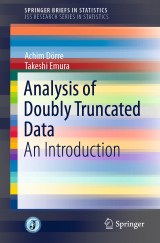Details

Analysis of Doubly Truncated Data
An IntroductionSpringerBriefs in Statistics
|
53,49 € |
|
| Verlag: | Springer |
| Format: | |
| Veröffentl.: | 13.05.2019 |
| ISBN/EAN: | 9789811362415 |
| Sprache: | englisch |
Dieses eBook enthält ein Wasserzeichen.
Beschreibungen
<p></p><p>This book introduces readers to statistical methodologies used to analyze doubly truncated data. The first book exclusively dedicated to the topic, it provides likelihood-based methods, Bayesian methods, non-parametric methods, and linear regression methods. These procedures can be used to effectively analyze continuous data, especially survival data arising in biostatistics and economics. Because truncation is a phenomenon that is often encountered in non-experimental studies, the methods presented here can be applied to many branches of science. The book provides R codes for most of the statistical methods, to help readers analyze their data. Given its scope, the book is ideally suited as a textbook for students of statistics, mathematics, econometrics, and other fields.</p><p></p>
<p>Chapter 1: Introduction to double-truncation.- Chapter 2: Parametric inference under special exponential family.- Chapter 3: Parametric inference under location-scale family.- Chapter 4: Bayes inference.- Chapter 5: Nonparametric inference.- Chapter 6: Linear regression.- Appendix A: Data (if German company data are available).- Appendix B: R codes for inference under exponential family.- Appendix C: R codes for inference under location-scale family.- Appendix D: R codes for Bayes inference.- Appendix E: R codes for linear regression.</p>
<p>Achim Dörre, University of Rostock</p>
<p> </p>
<p>Takeshi Emura, Chang Gung University</p><br>
<p> </p>
<p>Takeshi Emura, Chang Gung University</p><br>
This book introduces readers to statistical methodologies used to analyze doubly truncated data. The first book exclusively dedicated to the topic, it provides likelihood-based methods, Bayesian methods, non-parametric methods, and linear regression methods. These procedures can be used to effectively analyze continuous data, especially survival data arising in biostatistics and economics. Because truncation is a phenomenon that is often encountered in non-experimental studies, the methods presented here can be applied to many branches of science. The book provides R codes for most of the statistical methods, to help readers analyze their data. Given its scope, the book is ideally suited as a textbook for students of statistics, mathematics, econometrics, and other fields.
Serves as an accessible introductory textbook on the analysis of doubly truncated data for students of statistics, mathematics, and econometrics Provides illustrative examples from biostatistics, economics, and other fields, with R codes to help readers analyze their data Presents clearer and more detailed explanations than those found in most journal papers

















